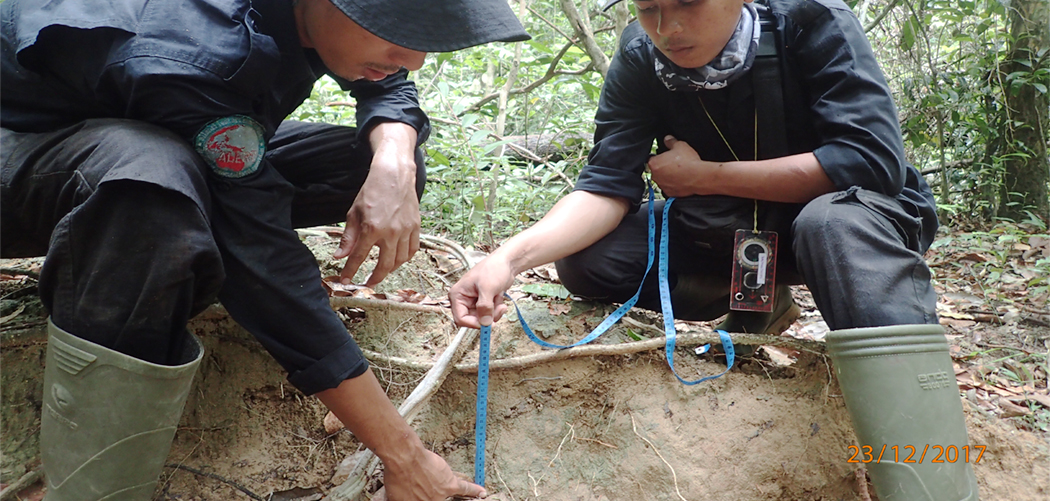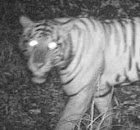Monday, May 15, 2017
Guest diary - Simona Colombo (Italy)
“May
14th
2017 started as a quite normal day, then it became an unforgetable
experience for me.
In the morning, ALeRT members
Danang, Yahya and Budi picked me up to go to Way Kambas NP and meet a
group of university students who came to help reforestation planting
new trees.
I just finished to plant my young tree, when Danang
received a phone call: there was a fire in Baru Reforestation area.
The team was immediatly needed to take action on site and I wanted to
join them in order to record the intervention and take pictures. So
we ran back to ALeRT office and we took the cross-country vehicle
used for fire fighting activity. Water and food for the team was
loaded and Yahya drove to the fire area. Along the way, local people
joined the team to help. They stayed on the car roof and, from
inside, I was thinking of them jumping because the road became worser
and worser as we got into the park: deep holes dug by the rain, rocks
and grass as high as the car windows. But Yahya is an experinced
driver and no one jumped off the roof. When we passed through low
vegetation, we could see for the first time the cloud of smoke coming
from the fire rising in the sky and for a moment that vision left me
without words.
As we approached the fire, I
realized it was made of several burnings spread around us. The car
engine was turned off and I was impressed by the sound I could now
listen to. When you think of a fire, you always imagine the flames,
the heat, the smell of ashes, but you never think about the sound.
That was the sound of the fire: not a whisper, but a loud crackling
voice filling up the air from every direction to let you know that
you are surrounded by danger. And I also heard its laugh with every
wind fever through the dry grass, making flames suddenly appear
where, just one second before, there was only a line of smoke.
Another car arrived with national
park staff to help. I watched those men and boys taking manual fire
estinguishers from the back of the vehicles, wearing hats insted of
helmets, headscarf instead of anti-smoke masks: that's what they have
to fight fires in the forest. They really need better equipmet, I
hope fundraising campaigns will work for this and all the other needs
to manage all ALeRT projectsand activities. One passing cloud helped
with a little rain, but not enough. I stayed at the car, climbed up
the roof and watched those courageous men go facing the flames. While
taking pictures, I was thinking about their passion for nature
conservation because I knew they fighted worse fires than this.
The first front of the fire was
extinct and, before facing the second one, the team had a break to
drink, eat and, of course, breathe again. They came back to the car
and asked if everyone is ok. They are so used to this kind of events
– 36 in 2016 and already 5 in 2017 – that my question sounded
sweet and funny to them.
Let's go fighting the second
front! That one looked immediately stronger, the air seemed liquid
and crossed by waves for the heating. Once again the team went into
the battle and I stayed on the car roof taking pictures, but this
time there was something new. I listened to a new sound besides the
forest burning: the cry of an elephant. I heard it again and it is
heartbreaking because it reminds me of a father calling his children
and telling them to run away. Later, Danang tell me the team often
finds dead animals after fires, sometimes the wind makes the flames
go so fast that even birds cannot escape. This time the elephants are
lucky, the wind is weak and brave men finally won the last fire.
On
the way back, we had a stop at Susukan
Baru reforestation centre
for lunch, it was four o'clock in the afternoon. The team takes time
to relax, Budi plays the guitar and someone is singing. The sun is
going down behind the trees and everything is golden around me. May
14th
2017 was just another day for Yahya, Danang, Budi (ALeRT staff),
Agustinus, Amrodi, Untoro, Deni, Sigit, Nugroho, Badri (National Park
staff), Dodo, Irfan, Misradi (helping friends from villages around
the park), but it was an incredible day to me.”
Read
more about FIGHTING FIRES IN TN WAY KAMBAS link to
information/project page
Visit
photo gallery
Subscribe to:
Post Comments
(
Atom
)









































 Enjoy the Way Kambas National Park endangered mega fauna and other rare wildlife species caught in video. Find mother and baby of Sumatran rhino, challenging young male Sumatran tiger, big family of Sumatran elephant, funny Malayan sun-bear and curious Malayan tapir.
Enjoy the Way Kambas National Park endangered mega fauna and other rare wildlife species caught in video. Find mother and baby of Sumatran rhino, challenging young male Sumatran tiger, big family of Sumatran elephant, funny Malayan sun-bear and curious Malayan tapir. It was written by Janos Olah & Attila Simay in Birding Asia magazine, on 2007. Not only the great variety of the otherwise scarce and hard to-come-by species is what makes this national park world-famous, but also the relative ease in finding them. No other place in sumatra that has 4 species of Frogmouth.
It was written by Janos Olah & Attila Simay in Birding Asia magazine, on 2007. Not only the great variety of the otherwise scarce and hard to-come-by species is what makes this national park world-famous, but also the relative ease in finding them. No other place in sumatra that has 4 species of Frogmouth.




Nice story :)
ReplyDelete